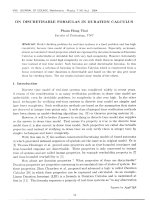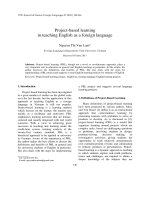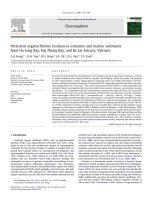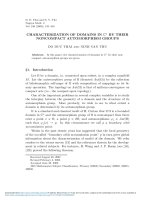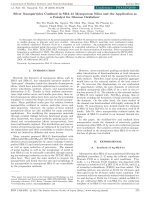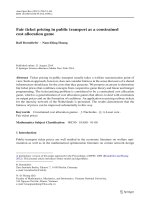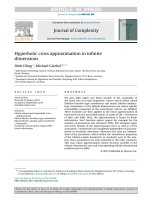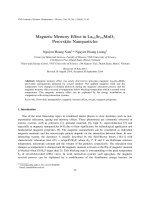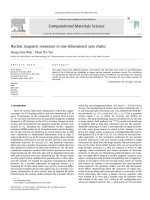DSpace at VNU: Silver nanoparticles confined in SBA-15 mesoporous silica and the application as a catalyst for glucose oxidation
Bạn đang xem bản rút gọn của tài liệu. Xem và tải ngay bản đầy đủ của tài liệu tại đây (1.25 MB, 4 trang )
e-Journal of Surface Science and Nanotechnology
23 June 2012
Conference - IWAMN2009 -
e-J. Surf. Sci. Nanotech. Vol. 10 (2012) 273-276
Silver Nanoparticles Confined in SBA-15 Mesoporous Silica and the Application as
a Catalyst for Glucose Oxidation∗
Bui Thi Thanh Ha, Nguyen Thi Minh Thu, Giang Thi Phuong Ly,
Nguyen Thanh Binh, Le Thanh Son, and Tran Thi Nhu Mai†
Faculty of Chemistry, Hanoi University of Science,
334 Nguyen Trai Road, Thanh Xuan, Hanoi, Vietnam
(Received 3 December 2009; Accepted 11 March 2012; Published 23 June 2012)
In this paper, the dispersion of Ag metal nanoparticles on SBA-15 mesoporous silica and its catalytic performance
to oxidize glucose to gluconic acid were studied. Mesoporous silica SBA-15 materials were synthesized using
the triblock copolymer Pluronic P123 as a template in acid condition. Ag nanoparticles were prepared using
impregnation method inside the pores of the support by controlled reduction of AgNO3 with sodium borohydrate
(NaBH4 ). The XRD, TEM, EDS, BET techniques were used for characterization of materials. Silver nanoparticle
formation is confirmed by TEM. The efficiency of glucose oxidation to gluconic acid is determinated by HPLC-RID
and LC-MS. Obtained results showed that it can prepare silver nanopartilces with particle diameter about 5 nm;
and catalyst based on these particles has quite efficiency in glucose oxidation to gluconic acid.
[DOI: 10.1380/ejssnt.2012.273]
Keywords: Ag nanoparticles; SBA-15; Glucose oxidation
I.
INTRODUCTION
Recently, the discovery of mesoporous silicas, such as
M41S and SBA-15, has stimulated intensive studies of
“host-guest” chemistry inside the channels of mesoporous
silicas, which have potential applications in catalysis, selective adsorbents, medical, sensors, and nanomaterials
fabrications [1–3]. Thanks to their uniform mesostructures, high surface areas, and tunable pore sizes, these ordered mesoporous silicas have been used as the promising
templates to control the shape and size of metal nanoparticles. Many published works gave the relation between
nanoparticles confined in various molecular sieves and
their properties. Moreover, the surface of these ordered
mesoporous silicas are also modified for many potential
applications. For modifying the mesoporous materials
through covalent linkage between functional groups and
silica framework, two major methods, grafting (post synthesis) and cocondensation (direct incorporation), have
been traditionally explored. The distribution and concentration of functional groups are influenced by reactivity of
the organosilane and their accessibility to surface silanols,
which are limited by diffusion and steric factors.
Many scientist prepared SBA-15 functionalized with
(CH3 O)3 Si(CH2 )3 N(CH3 )3 Cl (TPTAC) and further synthesized metal nanoparticles by anion exchange between
grafted SBA-15 and metal precursors inside the channels
as well as upon reduction of precursors. The amount
of metal loading as well as the morphology of metal in
host SBA-15 can be rationally controlled through repeating ion-exchange/reduction cycles in the TPTAC-SBA-15
silica host. They used the same method to prepare Au
nanoparticles and found that the size and morphology of
Au nanoparticles in mesoporous SBA-15 are controllable
by the preparation methods.
∗ This paper was presented at the International Workshop on Advanced Materials and Nanotechnology 2009 (IWAMN2009), Hanoi
University of Science, VNU, Hanoi, Vietnam, 24-25 November, 2009.
† Corresponding author:
However, above-mentioned grafting methods basically
allow introduction of functionalization at both intrapore
and extrapore media, which led the nanoparticles form at
both surfaces. Therefore, large metal particles aggregate
would form on the external surface of the host materials. To overcome this disadvantage, we can synthesized
Pt nanoclusters within the pore channels of selectively
modified mesoporous silica SBA-15 by a new in situ reduction process [5–8]. The silanols on the external surface
of SBA-15 were capped with –Si(CH3 )3 groups, thus effectively avoiding the formation of large particles outside
the channels. On the other hand, the inner surface of
the channel was functionalized with highly reducing Si–H
bonds. Pt nanoclusters were formed inside the channels
of SBA-15 from H2 PtCl5 by in situ reduction with Si–H
bonds. Like Pt, silver nanoparticles confined inside the
channels of SBA-15 resulted in an unusual thermal stability.
In this paper, the stabilizer-free and confined silver
nanoparticles inside the channels of selectively grafted
mesoporous silica SBA-15 by an in situ reduction process
were synthesized. The catalytic activity of silver nanoparticles confined in the mesoporous silica SBA-15 to the reduction of glucose was studied.
II.
A.
EXPERIMENTAL
Synthesis of Ag-SBA-15
Mesoporous silica SBA-15 was synthesized following the
published procedure [1–3] using the triblock copolymer
Pluronic P123 as a template in acid conditions. Typically, a 1 g Pluronic P123 template was dissolved with
stirring in a solution of 9.7 g HCl 12 M at 313 K, and 2.1 g
of tetraethyl orthosilicate (TEOS) was then added. The
resulting mixture was stirred at 313 K for 24 hours, and
then aged in air for 48 hours under static condition. The
recovered solid was extensively washed with deionized water and drying at 353 K for 12 hours yielded as-SBA-15.
To get calcinated SBA-15 (cal-SBA-15), the surfactant
template of as-SBA-15 was removed by calcination in air
c 2012 The Surface Science Society of Japan ( />ISSN 1348-0391 ⃝
273
Ha, et al.
Volume 10 (2012)
Mau SBA-15
d=91.693
4000
Mau Ag-SBA-15
4000
d=93.873
5000
3000
Lin (Cps)
Lin (Cps)
3000
2000
2000
1000
0
d=46.289
d=52.616
d=46.589
d=53.779
1000
0
0.5
1
2
3
4
5
6
7
8
9
10
0.5
1
2
3
4
2-Theta - Scale
File: Thuy CH17 Mau SBA-15(3).raw- Type: Locked Coupled - Start: 0.500o - End: 10.000o - Step: 0.010o –
Step time: 0.8s - Temp: 25 oC (Room) - Time Started: 2s - 2-Theta: 0.500 o - Theta: 0.250o - Chi: 0
5
6
7
8
9
10
2-Theta - Scale
File: Ha K9 Mau Ag-SBA-15.raw - Type: Locked Coupled - Start: 0.500o - End: 10.000o - Step: 0.010o –
Step time: 0.8s - Temp: 25 oC (Room) - Time Started: 4s - 2-Theta: 0.500 o - Theta: 0.250o - Chi: 0
FIG. 1: X-ray diffraction patterns of synthesized SBA-15 and Ag/SBA-15 (1).
at 823 K for 6 hours.
About 1 wt.% Ag catalyst was synthesized as follows: one certained amount silver nitrate was dissolved
on absolute alcohol. 1 g of SBA-15 was stirring on the
AgNO3 /C2 H5 OH solution in 2 hours, and then an solution of NaBH4 /C2 H5 OH was added dropwise. The solution is stirring in 3 hours at 343 K until form a brown
solution. The recovered solid was extensively washed with
deionized water and drying at 333 K.
20 ml Glucose 1.6 M solution and 0.1 g catalyst were
introduced in the reaction simultaneously. The solution
was stirred with a magnetic stirrer at about 700 rpm and
then it was bubbled by flowing air, and the reaction was
started. After the reaction, the aqueous solution was separated from the solid catalyst by filtration and cooled in
an ice bath.
D.
B.
Characterization methods
SBA-15 mesoporous silica was characterized by a combination of physical techniques. X-ray diffraction (XRD)
patterns were recorded using a SIMENS, XRD 5005 powder diffractometer system with CuKα radiation (Kα =
1.5406 ˚
A) with 0.2 step size and 1 s step time over the
range 0 < 2θ < 10. The transmission electron microscopy
(TEM) with a JEOL 3010 microscope. BET (Brunauer,
Emmett and Teller) specific surface areas were obtained
from the nitrogen adsorption experiments measured at
77.35 K after degassing the samples below 10−3 Torr at
473 K for 2 h using an Autosorb-1C (Quantachrome) unit.
The pore size distribution was determined from the desorption branch of the isotherm by BJH (Barrett- JoynerHalenda) method. The total pore volume was calculated
as the amount of nitrogen adsorbed at the relative pressure until 0.99. Pore wall thickness
√ was calculated as:
Pore wall thickness
=
d(100)
×
2/
3− pore diameter,
√
where d(100) × 2/ 3 represents the unit cell parameter
and d(100) is the d-spacing value of the (100) diffraction
peak in XRD patterns of the samples. Chemical composition analysis was performed with Varian Vista Ax
inductively coupled plasma-atomic emission spectroscopy
(ICP-AES) spectrometer.
C.
Catalytic reaction procedure
Catalytic reactions were performed in a polypropylene
copolymer (PPCO) batch reactor (40 mL) equipped with
two tubes for gas inlet and gas outlet of the reflux condenser. The typical reaction procedure was as follows:
274
Products analysis
The resultant aqueous solution was analyzed with two
high performance liquid chromatography (HPLC) systems. The HPLC measurement employed a post-column
method using bromothymol blue (BTB) equipped with
an Hitachi L-2420 UV-vis detector (wavelength 440 nm),
two Hitachi L-2130 HPLC pumps and double columns
of Shodex RSpack KC-811 using 3 mmol L−1 HClO4 as
eluent at a flow rate of 1.0 mL min−1 at 313 K for the determination of carboxylic acids. The other HPLC system
was equipped with a Hitachi L-7490 RI detector, a Hitachi
L-6200 HPLC pump and a column of Shodex Sugar 0810
using water as eluent at a flow rate of 1.0 mL min−1 at
353 K for the determination of sugars and alcohols. The
products were determined based on the standard solutions
prepared by dissolving each commercial sodium carboxylate, sugars, and alcohols in distilled deionized water.
III.
RESULTS AND DISCUSSIONS
A.
Characterization
Figure 1 shows low angle X-ray diffraction patterns of
the calcined porous silica host and the calcined doped
sample with 1.0 wt.% Ag. The SBA-15 sample have a
strong peak in d(100) plane with 2 is about 0.90, and two
weak peak are corresponded to d(110) and d(200) planes,
indicating ordered pore structure of SBA-15. With the
calcined doped sample with 1.0 wt.% Ag, 3 peaks appearing at low angle (2 =0.9, 1.6, 1.9) correspond to (100),
(110), (200) planes of SBA-15 indicating ordered pore
structure of SBA-15, which suggests that the hexagonal
pore structure of SBA-15 should be retained after being
(J-Stage: />
e-Journal of Surface Science and Nanotechnology
Volume 10 (2012)
Ag-SBA15-006
Ag/SBA15
SBA15
20nm
100nm
(b)
(a)
cps
Energy (KeV)
Ag-SBA15-005
Ag/SBA15
100nm
(d)
(c)
Figure 2. (a) Representative TEM images of SBA-15 sample, (b), (c) The TEM images of
FIG. 2: (a) Representative TEM images of SBA-15 sample. (b), (c) The TEM images of the calcined Ag/SBA-15. (d) The
simultaneous EDS spectrum.
incorporated with Ag.
B.
TEM and EDS images
The TEM images of the calcined porous silica host
SBA-15 and calcined Ag/SBA-15 samples are shown in
Figs. 2(a), (b) and (c). In agreement with the above
SAXRD results, the synthesized sample is of hexagonal mesostructure and remains intact after supported
with Ag. The simultaneous EDS analysis, as shown in
Fig. 2(d), indicates that Ag element exists on the mesoporous host.
C.
N2 sorption isotherms
Figure 3 presents the N2 adsorption/desorption
isotherm of the SBA-15 and Ag/SBA-15 samples. The
Ag/SBA-15 sample exhibits a typical adsorption curve
of type IV, which is the characteristic of nanostructured
materials with uniform mesopores. The adsorption and
desorption isotherms show a large increase in the relative pressure (P/P0 ) range from 0.64 to 0.86 (Fig. 3(a))
and 0.45 to 0.8 (Fig. 3(b)), which is due to the capillary condensation of nitrogen within the mesopores. The
sharpness of the inflection step reflects the uniform pore
TABLE I: Textural properties obtained from XRD and N2
physisorption.
Sample
SBA-15
Ag/SBA-15
SBET (m2 /g)
727.3818
540.7822
VBJH (cm3 /g)
1.080809
0.581810
t (˚
A)
48.9596
62.8432
size distribution of the Ag/SBA-15 sample. In consonance with results of XRD, the N2 adsorption/desorption
isotherm also confirm that the Ag/SBA-15 sample possess
high structural integrity.
Table I shows SBET, VBJH, t (pore wall thickness) values. The total pore volume of SBA-15 sample is double
higher than the value of the Ag/SBA-15 sample. It proves
that there is presence of silver nanoparticles in mesoporous pore. Beside, the pore wall thickness of Ag/SBA15 sample is higher than the value of the SBA-15 sample,
indicated that incorporation with Ag in pores would increase stability of the host material.
D.
Catalytic activity
The catalytic performance of prepared Ag/SBA-15
sample for the glucose oxidation was investigated. The
(J-Stage: />
275
Ha, et al.
Volume 10 (2012)
Isotherm linear Plot
Quantity absorbed (cm3/s STP)
Quantity absorbed (cm3/s STP)
Isotherm linear Plot
Relative pressure (P/Po)
Relative pressure (P/Po)
(a)
(b)
Figure 3: N2 sorption/desorption isotherms for SBA-15 sample (a); and Ag/SBA-15
FIG. 3: N2 sorption/desorption isotherms for (a) SBA-15 sample and (b) Ag/SBA-15 sample.
10
5
0
0
10
20
30
40
50
60
70
80
Figure 4. HPLC analyst
of the glucose oxidation
Time (min)
In figure 4, we can see that glucose is oxidized to acid gluconic, and a small
FIG. 4: HPLC analyst of the glucose oxidation.
results are presented in Fig. 4. In Fig. 4, we can see that
glucose is oxidized to acid gluconic, and a small part is
isomerized to fructose because the reaction condition is
base one.
IV.
CONCLUSION
Nano-scale silver supported mesoporous molecular sieve
Ag/SBA-15 was directly prepared by one-pot synthesis method using hexadecyltrimethylammonium bromide
(CTAB) as both a stabilizing agent for Ag nanoparticles
and a template for SBA-15 host. XRD result shows that
[1] B. L. Newalkar, S. Komarneni, and H. Katsuki, Chem.
Commun. 2389 (2000).
[2] P. Dibandjo, L. Bois, C. Estournes, B. Durand, and
P. Miele, Microporous and Mesoporous Mater. 111, 643
(2008).
[3] Y. Wan, Y.-L. Min, S.-H. Yu, Langmuir 24, 5024 (2008).
[4] P. V. Adhyapaka, P. Karandikarb, K. Vijayamohananb, A.
A. Athawalec, and A. J. Chandwadkar, Mater. Lett. 58,
1168 (2004).
276
there was no appreciable incorporation of silver into the
mesoporous matrix, silver nanoparticles present inside the
channels or deposits on the external surface of SBA-15.
Ag/SBA-15 is found to be an effective catalyst for the
glucose oxidation to acid gluconic.
Acknowledgments
Authors special thanks to Hanoi National University,
Ministry of Industry and Trade, and Nafosted for management and financial support.
[5] X.-G. Zhao, J.-L. Shi, B. Hu, L.-X. Zhang, and Z.-L. Hua,
Mater. Lett. 58, 2152 (2004).
[6] H. Wanga, X. Qiaoa, J. Chena, and S. Ding, Colloids and
Surfaces A: Physicochem. Eng. Aspects 256, 111 (2005).
[7] O. Sawai and Y. Oshimab, J. Supercritical Fluids 47, 240
(2008).
[8] A. Y. Khodakov, V. L. Zholobenko, R. Bechara, and D. Durand, Microporous and Mesoporous Mater. 79, 29 (2005).
(J-Stage: />

